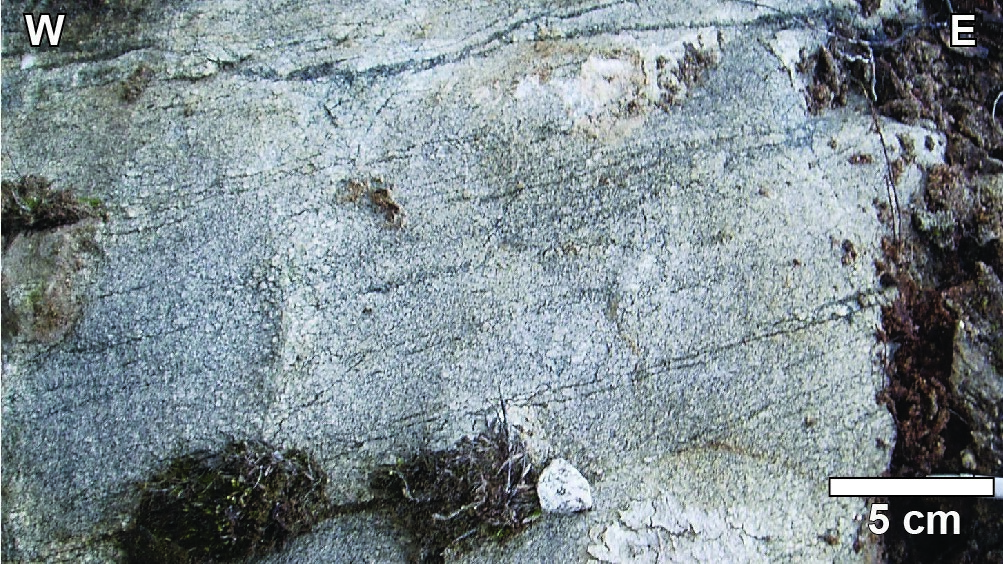
Last modified:
Translation of original French
| Author: | Daigneault and Allard, 1983 |
| Age: | Neoarchean |
| Reference section: | Series of reference outcrops easily accessible along Road 167 |
| Type area: | South of Chibougamau, southeastern portion of NTS sheet 32G09 |
| Geological province: | Superior Province |
| Geological subdivision: | Abitibi Subprovince |
| Lithology: | Tonalite, granodiorite |
| Type: | Lithodemic |
| Rank: | Lithodeme |
| Status: | Formal |
| Use: | Active |
None
Background
The intrusion was originally described as the “Rivière Boisvert Pluton” by Daigneault and Allard (1983, 1984) and Daigneault (1986). It is more simply described as “Boisvert Pluton” in more recent publications (Daigneault, 1991; Roy et al., 2005).
Description
According to Roy et al.,, (2005, p. 12), the Boisvert Pluton is “composed of leucotonalite (trondhjemite) and two mica granodiorite with a minor amount of tonalite or diorite richer in mafic minerals. It is white, locally pinkish or brownish, in altered patina and light grey in fresh exposure. It is medium grained and foliated, highlighted by the alignment of micas that tend to concentrate in clusters. It is intensely foliated to mylonitic at its western contact with mafic volcanics of the Obatogamau Formation. This contact also corresponds to the Lac Dufresne Deformation Zone interpreted as the western limit of the Grenville Front Tectonic Zone. At its southeastern edge, banding gradually increases towards tonalitic gneiss and contact is diffuse. Along NNE faults that cut the Boisvert Pluton, leucotonalite is heavily altered in epidote, hematite and chlorite and has undergone brittle to ductile deformation. The Boisvert Pluton is cut by numerous intrusions or veins, usually of pegmatitic granite. Granitic mobilisate derived from partial melting is locally present but of minor importance (<5%). Amphibolite enclaves are common in the pluton and can reach up to 5 km long by several hundred metres thick. They consist of fine to medium-grained banded garnet amphibolite. In leucotonalite and granodiorite thin sections, microcline is observed as small interstitial grains, which highlights the relatively potassic character of the Boisvert Pluton in comparison to other felsic intrusions in the region. Quartz often forms lenticular grain clusters. The most important mafic minerals are green biotite, epidote and muscovite. Hornblende and garnet are scarce. The most common accessory minerals are titanite, allanite, magnetite, rutile, apatite and zircon.”
Thickness and Distribution
The Boisvert Pluton is an ovoid intrusion whose long axis measures 32 km and oriented NNE-SSW, parallel to the Grenville Front Tectonic Zone. The WNW-ESE-oriented short axis is 18 km long.
Dating
A tonalite sample returned a crystallization age of 2697 ±3 Ma (Davis et al., 2005; TIMS U-Pb on zircons), placing the Boisvert Pluton in the category of syntectonic plutons of northeastern Abitibi (Goutier and Melançon, 2010).
| Isotopic System | Mineral | Crystallization Age (Ma) | (+) | (-) | Reference(s) |
| U-Pb | Zircon | 2739 | 10 | 10 | Davis et al., 2005 |
Stratigraphic Relationship(s)
The Boisvert Pluton cuts mafic volcanic rocks of the Obatogamau Formation and their amphibolite facies equivalents characterizing the Grenville Front Tectonic Zone transition zone (Daigneault and Allard, 1994; Roy et al., 2005). At its eastern limit, it cuts quartzofeldspathic gneiss, hornblende-biotite gneiss and mafic gneiss. To the south, it cuts gneissic (locally migmatitic) tonalites intruded by pegmatites.
Paleontology
Does not apply.
References
|
Author(s) |
Title | Year of Publication | Hyperlink (EXAMINE or other) |
|---|---|---|---|
| DAIGNEAULT, R. | Géologie de la partie nord-est du canton de Dollier – Région de Chibougamau. Ministère de l’Énergie et des Ressources, Québec; DV 85-19, 1 plan. | 1986 | DV 85-19 |
| DAIGNEAULT, R. | Évolution structurale du segment de roches vertes de Chibougamau, Sous-province archéenne de l’Abitibi, Québec. Université Laval; doctoral thesis, 352 pages. | 1991 | – |
| DAIGNEAULT, R. – ALLARD, G.O. | Stratigraphie et structure de la région de Chibougamau. In Stratigraphie des ensembles volcano-sédimentaires archéens de l’Abitibi : État des connaissances, Séminaire d’information 1983. Ministère des Ressources naturelles, Québec; DV 83-11, pages 1-17. | 1983 | DV 83-11 |
| DAIGNEAULT, R. – ALLARD, G.O. | Évolution tectonique d’une portion du sillon de roches vertes de Chibougamau. In Chibougamau : stratigraphy and mineralization (Guha, J. and Chown, E.H., editors). Canadian Institute of Mining and Metallurgy; volume 34, pages 211-228. | 1984 | – |
| DAIGNEAULT, R. – ALLARD, G.O. | Transformation of Archean structural inheritance at the Grenvillian Foreland Parautochton Transition Zone, Chibougamau, Quebec. Canadian Journal of Earth Sciences; volume 31, pages 470-488. | 1994 | Source |
| DAVIS, D.W. – DAVID, J. – DION, C. – GOUTIER, J. – BANDYAYERA, D. – RHÉAUME, P. – ROY, P. | Datations U-Pb effectuées en support aux travaux de cartographie géologique et de compilation géoscientifique du SGNO (2003-2004). Ministère des Ressources naturelles et de la Faune, Québec; RP 2005-02, 20 pages. | 2005 | RP 2005-02 |
| GOUTIER, J. – MELANÇON, M. | Compilation géologique de la Sous-province de l’Abitibi (version préliminaire). Ministère des Ressources naturelles et de la Faune; RP 2010-04, 1 page, 2 plans. | 2010 | RP 2010-04 |
| ROY, P. – TURCOTTE, S. – CADÉRON, S. – HOULE, P. – SHARMA, K.N.M. | Géologie de la région du lac Charron (32G/08 et 32G/09). Ministère des Ressources naturelles et de la Faune, Québec; RG 2005-02, 35 pages, 3 plans. | 2005 | RG 2005-02 |


